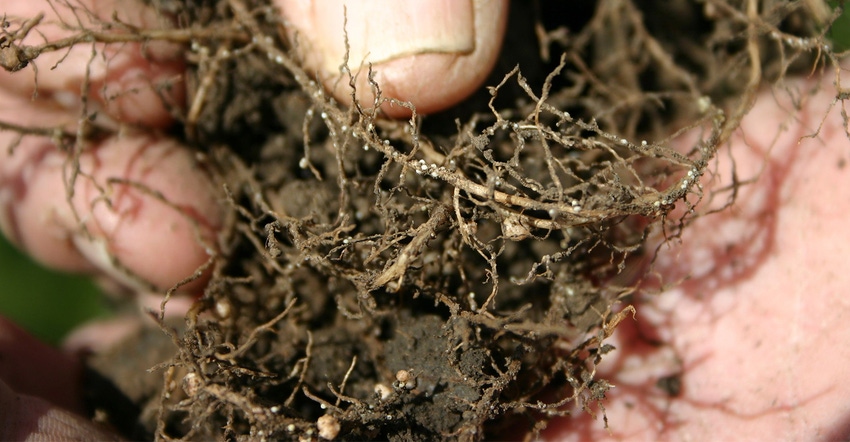March 16, 2017

It might be a good idea to sample fields you are going to plant to soybeans this spring for soybean cyst nematode, says Emmanuel Byamukama, South Dakota State University Extension plant pathologist.
If tests show you have more than 10,000 eggs per 100 cubic centimeters of soil, you might want to use a nematicide seed treatment to reduce SCN yield losses. You can also use the results of the soil test to determine if your SCN management — primarily using longer rotations and planting SCN-resistant varieties — is working. If it is, you will find SCN populations to be declining. If it isn’t, the numbers will be rising.
SCN is widespread in eastern South Dakota and North Dakota. Some samples collected have had as many as 70,000 eggs per 100 cc of soil.
Free tests
SCN soil analysis is free for South Dakotans and North Dakotans, courtesy of the South Dakota Soybean Research and Promotion Council and the North Dakota Soybean Council.
You can send soil samples to the following laboratories and get results back in about one week:
South Dakota
SDSU Plant Diagnostic Clinic
North Campus Drive
SPSB 153, Box 2108
Brookings, SD 57007
North Dakota
Agvise
604 ND Highway 15
Northwood, ND 58267
You can also send samples to other labs if you are not participating in the free testing program.
Soil sampling tips
To sample for SCN, use a soil probe or shovel and take 20 soil cores. Make sure you sample field entrances, low-yielding areas and along fence lines where SCN is mostly spreading from, says Sam Markell, North Dakota State University Extension plant pathologist. In areas where there have been high levels of SCN found, divide larger fields into 10- to 20-acre sections to sample.
You can sample for SCN anytime, provided the soil is not too wet (can form a paste once rubbed between the fingers) and not frozen so that a spade or soil probe can be inserted 6 inches deep. Mix the soil cores well, and package up a pint of soil for the laboratory.
30% yield loss
SCN can cause up to 30% yield loss without causing obvious aboveground symptoms. Sometimes SCN symptoms can be confused with those caused by other stress factors, such as nutrient deficiencies or iron chlorosis.
“The most reliable method for determining the presence of SCN in the soil is through a soil test. Taking advantage of this service will help you get a better picture of the current SCN status of a field before planting soybeans this season,” Byamukama says.
SCN can be managed primarily through planting SCN-resistant cultivars and through crop rotation. If SCN has been detected in your field, plant soybean cultivars with SCN resistance. Typically, SCN-resistant varieties do not cost any more than seed without SCN resistance. If a high SCN population has been found (more than 10,000 eggs per 100 cc of soil), rotate out of soybeans for more than two years, Byamukama recommends.
Nematicide seed treatments can also help, especially for fields with high SCN population density. There are several nematicides labeled for use against SCN. When applied at planting, nematicides may last long enough to provide an economic yield benefit.
Nematicide performance will depend on soil conditions, temperatures and rainfall. A yield benefit is not guaranteed, and nematicides are expensive. Consider economics, the initial SCN population, and environmental and personal health concerns when deciding whether to use nematicides.
Sources: SDSU, Iowa State University and NDSU Extension services
You May Also Like




